

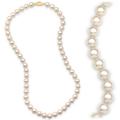

|
|
|
|
|
Fighting the Recession and Pearl Beads
This monthís theme is beating the
recession, and June's
birthstone pearls. Scroll down, or click one of the links below.
Some orders may be delayed between 7th-17th June - e-mail if this is a problem.
Thanks to those who
called on us in Nantwich, it was a great success. Customers in London
can visit us at Kempton Park on 6th-7th June - details
here.
If you
weren't mailed this newsletter enter your e-mail address
here
to receive next month's.
Fighting the Recession
Cash for Jewelry is out there with your Name on it!
How to sell Home-crafted Jewelry
How Much
do I charge?
Pearls for the Spring!
How to Tell Real Pearls from Fake Pearls
See us in the UK at a West London Bead Fair -
6th & 7th June 09
Fighting
the Recession
![]() Now is the worst financial crisis most of us have lived through.
However, the good news is itís not too late to prepare yourself for difficult times ahead. There are some basic things we can do to weather the
storm.
Now is the worst financial crisis most of us have lived through.
However, the good news is itís not too late to prepare yourself for difficult times ahead. There are some basic things we can do to weather the
storm. 
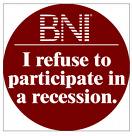
 Donít panic, protect your income.
Unemployment will increase, so keep your job by working more hours,
harder, and not complaining. If you
are unlucky enough to be already laid off, improve your rťsumť, network
all ways you can, and get out searching.
Donít panic, protect your income.
Unemployment will increase, so keep your job by working more hours,
harder, and not complaining. If you
are unlucky enough to be already laid off, improve your rťsumť, network
all ways you can, and get out searching.

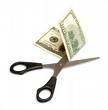
 Itís important to keep your home and save at least six-months income for future
security. Donít take risks putting your
house up to guarantee high-interest credit.
Live within your means and hang on.
Donít cut holidays, just make them cheaper.
Rip up store cards and get used to buying with cash.
The months ahead will be hard Ė don't be naive. If the media says
"not long to go": you can be sure it's wrong! The recession won't end until everyone says otherwise. See our article about The Fall of Money
here.
top of page
Itís important to keep your home and save at least six-months income for future
security. Donít take risks putting your
house up to guarantee high-interest credit.
Live within your means and hang on.
Donít cut holidays, just make them cheaper.
Rip up store cards and get used to buying with cash.
The months ahead will be hard Ė don't be naive. If the media says
"not long to go": you can be sure it's wrong! The recession won't end until everyone says otherwise. See our article about The Fall of Money
here.
top of page
Cash for good jewelry is out there with your name in it!
 For years youíve been threading beads, designing jewelry. Your hobby has made
you an expert in the craft. Your
drawers are overflowing necklaces, earrings, and bracelets - and you have run out
of friends and relatives to give these away. Now is the time for you to make
money from your handcrafted jewelry by selling them.
For years youíve been threading beads, designing jewelry. Your hobby has made
you an expert in the craft. Your
drawers are overflowing necklaces, earrings, and bracelets - and you have run out
of friends and relatives to give these away. Now is the time for you to make
money from your handcrafted jewelry by selling them.
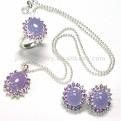 Donít hesitate taking your handcrafted jewelry hobby to the next level.
You need the extra lucrative income to fight the recession, and itís a
lot more fun than ďworkingĒ. Itís
easy to sell handcrafted jewelry, since there is always a market for
originality. Large jewelry companies
canít compete with you because of the high-cost of design.
One-offs donít come cheap.
top of page
Donít hesitate taking your handcrafted jewelry hobby to the next level.
You need the extra lucrative income to fight the recession, and itís a
lot more fun than ďworkingĒ. Itís
easy to sell handcrafted jewelry, since there is always a market for
originality. Large jewelry companies
canít compete with you because of the high-cost of design.
One-offs donít come cheap.
top of page
How to sell your home-crafted jewelry
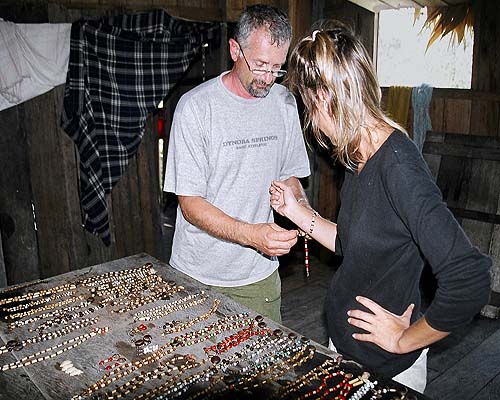
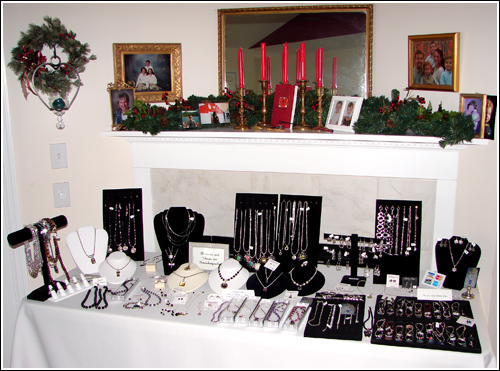
1.
Try home jewelry parties. Invite
your friends and neighbors round for snacks, cheese and wine.
When the small talk begins, show guests your latest creations. Let them
look and feel your products. Have mirrors handy and allow guests to
try your jewels for size. This relaxed and friendly environment works well.
For more on this see one of our old newsletters
here
2.
Handicraft Fairs are cheap and easy to sell from.
Customers there are looking to buy what you make, and they are also
potential contacts for future jewelry parties.
Look online where these fairs are held near you.
Take lots of lights to show your creations off the best.
3.
Online stores allow you to reach a much-larger market.
Although eBay is saturated these days, itís simple to set up a shop
there. Itís also easy and cheap to
publish your own web site or online shop, but this will require marketing skills
Ė put the URL on your business cards and advertise in jewelry publications.
How much do I charge?
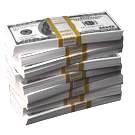 Just note the cost of materials, how many hours you worked on making and
selling, and the overheads (food at a jewelry party or rent for a fair). Then
decide how much you want to pay yourself (say $10 an hour), double-up on all
material costs, and add the overheads.
Donít overlook other expenses to add, like telephone, transport,
advertising, or hosting a website.
Just note the cost of materials, how many hours you worked on making and
selling, and the overheads (food at a jewelry party or rent for a fair). Then
decide how much you want to pay yourself (say $10 an hour), double-up on all
material costs, and add the overheads.
Donít overlook other expenses to add, like telephone, transport,
advertising, or hosting a website.
 As an example, say you spend $100 on beads, 5-hours making ten designs and
5-hours selling eight of them, plus it cost you another $100 for cheese, wine,
and other expenses. Then you would
need to take $400 ($100 x 2 + $10 x 10 + $100), divided by the eight items sold =
$50 each. Obviously to start with
you would have to estimate and not all designs will cost the same, but you get the idea.
As an example, say you spend $100 on beads, 5-hours making ten designs and
5-hours selling eight of them, plus it cost you another $100 for cheese, wine,
and other expenses. Then you would
need to take $400 ($100 x 2 + $10 x 10 + $100), divided by the eight items sold =
$50 each. Obviously to start with
you would have to estimate and not all designs will cost the same, but you get the idea.
Making money out of your handcrafted jewelry is not as difficult as it seems.
With determination and hard work you could be earning from your hobby in no time.
Don't hesitate - Go For It Now!
Pearls for the Spring

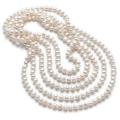
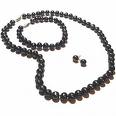
Pearl jewelry is great for the spring, as fresh and as
crisp as the air. Pearls have always been popular Ė a classic never going
out of style. There are some beautiful strands of pearls these days, with
amazing shapes and colors in freshwater pearls. Like pink, peach, lavender,
blue, and even yellow. At one time freshwater pearls were only available as
white rice shaped. Until advanced dyes in China now produce almost any color
under the sun.
I believe todayís popularity has a lot to do with price. Since pearls are so affordable, they can be worn by more people. Though it still takes a few years to grow a pearl, China has developed a system that has enabled them to produce large quantities cheaply. While Chinaís pearl process has grown, Japanís pearl industry has slowed down due to water pollution and high costs. top of page
The least expensive cultured pearls today rival the most expensive natural pearls ever found. Natural freshwater pearls occur in mussels for the same reason saltwater pearls occur in oysters. Foreign material inside a mussel can't be expelled. To reduce irritation, the mollusk coats the intruder with the same secretion it uses for shell-building, nacre. To cultivate a pearl, farmers slit the mussel and insert small pieces of live tissue from another mussel.
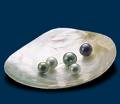 The ancient Chinese practiced this technique, but the first
real cultured freshwater pearls originated in Japan. In the 1930's, Japanese
farmers by Lake Biwa achieved natural colors unseen in saltwater pearls.
However, water pollution today has virtually destroyed pearl production there.
China now has the resources that Japan lacks: many large lakes, rivers, and a
low-cost work force. The first Chinese cultured pearls were basic, until the
1990's when China revolutionized pearling. Shapes, luster, and colors of the new
Chinese pearls now surpass Biwa quality. Copying the Japanese to improve
off-white and mottling, China uses a mild bleach, bright lights, and heat.
Natural freshwater pearls are usually odd shapes. So for more roundness, the
Chinese now reshape rejected pearls into spheres, and then nucleate mussels with
them. However, the word ďBiwaĒ can now also refer to the irregular shape of
any cultured pearl.
The ancient Chinese practiced this technique, but the first
real cultured freshwater pearls originated in Japan. In the 1930's, Japanese
farmers by Lake Biwa achieved natural colors unseen in saltwater pearls.
However, water pollution today has virtually destroyed pearl production there.
China now has the resources that Japan lacks: many large lakes, rivers, and a
low-cost work force. The first Chinese cultured pearls were basic, until the
1990's when China revolutionized pearling. Shapes, luster, and colors of the new
Chinese pearls now surpass Biwa quality. Copying the Japanese to improve
off-white and mottling, China uses a mild bleach, bright lights, and heat.
Natural freshwater pearls are usually odd shapes. So for more roundness, the
Chinese now reshape rejected pearls into spheres, and then nucleate mussels with
them. However, the word ďBiwaĒ can now also refer to the irregular shape of
any cultured pearl.
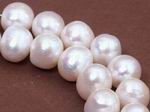
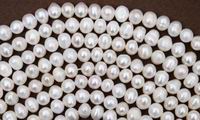 The best pearls have thick overlapping layers of nacre.
This can be tested by viewing its "luster". Roll the pearl with a pen in good
light - the best pearls will reflect the pen the most. A large pearl is only
more valuable if it's the same quality as a smaller one - and the rounder the
better. Being an organic gem, grooves, pits, or dents are expected. However,
matching color for a complete necklace is important. Freshwater pearls are
popular for their colors: white, silvery-white, pink, red, copper, brown,
lavender, purple, green, blue, and yellow. The most desirable are the pastel
pinks, roses, lavenders, and purples. Color comes from the mussel species and
water quality. Generally pearls assume the color of the shell in which they
form, but permanent dyes are used today for most saturated colors.
top of page
The best pearls have thick overlapping layers of nacre.
This can be tested by viewing its "luster". Roll the pearl with a pen in good
light - the best pearls will reflect the pen the most. A large pearl is only
more valuable if it's the same quality as a smaller one - and the rounder the
better. Being an organic gem, grooves, pits, or dents are expected. However,
matching color for a complete necklace is important. Freshwater pearls are
popular for their colors: white, silvery-white, pink, red, copper, brown,
lavender, purple, green, blue, and yellow. The most desirable are the pastel
pinks, roses, lavenders, and purples. Color comes from the mussel species and
water quality. Generally pearls assume the color of the shell in which they
form, but permanent dyes are used today for most saturated colors.
top of page
If you look very closely, youíll see tiny knots in between each pearl bead on a necklace. Many of your finer beaded jewelry is knotted because knots keep the beads from rubbing against each other - and if the necklace breaks, beads wonít go flying. Knotting also makes the necklace drape nicely and adds length so you need less beads. Pearls should be restrung every 1-2 years, depending on the amount of wear and the exposure to hair spray, perfume, body oils, lotions, moisture, and perspiration they receive. These elements can wear and dirty the silk and cause a potential break point for the strand.
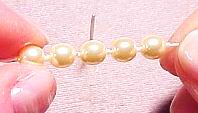 There are a few ways to knot a beaded necklace, but Iíll
only tell you the easiest for beginners. First, youíll need to choose a type of
cord to use. There are two types that are usually used for knotting: silk and
nylon. Silk is traditional, however many complain that it snags and frays. Nylon
cord can also be used. Both come in a variety of colors. They can be purchased
on small cards with about 6 feet of cord and a needle attached or, for the
serious knotter, larger spools can be purchased with separate needles. They also
come in different sizes. The thicker cord is used for the larger beads since the
holes in the beads are larger. For the beginnerís technique, two strands are put
through each bead, so a thinner size is needed. For 6mm beads, use size 2 for
this technique, and try to match the color of the cord with the color of the
beads.
There are a few ways to knot a beaded necklace, but Iíll
only tell you the easiest for beginners. First, youíll need to choose a type of
cord to use. There are two types that are usually used for knotting: silk and
nylon. Silk is traditional, however many complain that it snags and frays. Nylon
cord can also be used. Both come in a variety of colors. They can be purchased
on small cards with about 6 feet of cord and a needle attached or, for the
serious knotter, larger spools can be purchased with separate needles. They also
come in different sizes. The thicker cord is used for the larger beads since the
holes in the beads are larger. For the beginnerís technique, two strands are put
through each bead, so a thinner size is needed. For 6mm beads, use size 2 for
this technique, and try to match the color of the cord with the color of the
beads.
A very-popular way to start any beaded necklace is with bead tips (clamp shells). The only difference here is that two strands of the cord are inserted through the bead tip instead of one. Once the necklace is started, string on a bead, and make an over hand knot. Make the knot tight so itís snug up against the bead. Continue to do this: string a bead, make an over hand knot, string a bead, make an over hand knot. Thatís it. Finish the necklace as you would any beaded necklace whether itís knotted or not. This beginnerís way is a lot easier than using one strand of cord, and the results look almost the same. top of page
How to
Tell Real Pearls from Fake Pearls
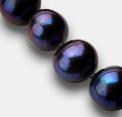

If you are buying pearls, you may be able to identify fake pearls by their name: simulated, faux, glass, plastic, resin, artificial, manmade. Genuine pearls are usually either natural or cultured. Real pearls may come from freshwater or saltwater and from a variety of molluscs (not just oysters). They are both formed from the same material and both are found in "baroque" shapes as well as round. It is also very difficult to tell whether a pearl comes from saltwater or freshwater. To further confuse things, there are also shell pearls and genuine pearls which have been treated, such as coatings or faceting. Before you buy or sell pearls, you need to know whether they are real or not. Here are some ways to tell them apart: top of page
Close Inspection



Take your pearls out into the sun or hold them under a bright light. Unless they are very expensive, genuine pearls won't look perfectly matched. You will be able to see variations in their iridescence (orient) and color. If the pearls are perfectly matched for color and overtones, they are most probably fake.
If your pearl seller offers expensive pearls that are perfectly matched, the cost of a gemologist certificate (from a gemologist of your choice) is a minimal part of the investment. It costs about $150 to have pearls tested, as opposed to several thousands of dollars for the type of pearls that warrant the test. An x-ray will show the inside of the pearl, including variations in density, the presence or absence of a parasite that might have caused the formation of a natural pearl, and the characteristic shapes of drill holes.
 As is true with diamonds, magnification reveals a lot about
the quality of a pearl. You can see the characteristic ridges and irregularities
of real pearls or the grainy smoothness of fakes. You can examine drill holes to
see the interface between the nacre and what lies beneath it. You can read any
writing on the clasp or setting. Cutting a pearl open will reveal its true nature. Natural
pearls are comprised of many layers of nacre. Cultured pearls have a shell
(mother-of-pearl) core covered with a thin layer of nacre (usually less than
half a millimeter). Fake pearls have a core with one or more layers of coating
applied to them, which tends to flake away from the core upon cutting.
As is true with diamonds, magnification reveals a lot about
the quality of a pearl. You can see the characteristic ridges and irregularities
of real pearls or the grainy smoothness of fakes. You can examine drill holes to
see the interface between the nacre and what lies beneath it. You can read any
writing on the clasp or setting. Cutting a pearl open will reveal its true nature. Natural
pearls are comprised of many layers of nacre. Cultured pearls have a shell
(mother-of-pearl) core covered with a thin layer of nacre (usually less than
half a millimeter). Fake pearls have a core with one or more layers of coating
applied to them, which tends to flake away from the core upon cutting.
 You can also try the tooth test. Rub the surface of the
pearl over your teeth. Supposedly a real pearl feels gritty while a faux pearl
feels smooth. Real pearls are made up of layers of nacre that are deposited like
sand on a beach. The slight waves in the nacre can produce a bumpy feeling
against the teeth. However, if the pearls are dyed, the dye can fill in natural
depressions, making them feel smooth. Also, some synthetic pearls are made to
look and feel like real pearls.
top of page
You can also try the tooth test. Rub the surface of the
pearl over your teeth. Supposedly a real pearl feels gritty while a faux pearl
feels smooth. Real pearls are made up of layers of nacre that are deposited like
sand on a beach. The slight waves in the nacre can produce a bumpy feeling
against the teeth. However, if the pearls are dyed, the dye can fill in natural
depressions, making them feel smooth. Also, some synthetic pearls are made to
look and feel like real pearls.
top of page
Other Clues
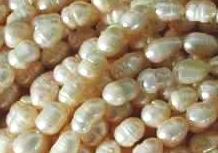 Fakes usually look 'flat'. Real pearls are usually not
perfect - having grooves in their nacre, bumps, ridges, or pits. They vary in
size and shape from one to another. These rings and grooves of genuine pearls
can make inexperienced people think the marks are from molding of a fake. Real
pearls come in many shapes, tending not to be perfectly round, so a perfect
sphere should be suspect. Expensive genuine pearls may be round, so you must
check other clues. Some fakes are made to look irregular, and glass pearls often
have flattened ends or slightly oval shapes. Also, genuine pearls tend to warm
to the skin faster than glass pearls - but plastic pearls tend to feel warm
right away. Real pearls are usually heavier for their size than plastic, resin,
or hollow glass pearls.
Fakes usually look 'flat'. Real pearls are usually not
perfect - having grooves in their nacre, bumps, ridges, or pits. They vary in
size and shape from one to another. These rings and grooves of genuine pearls
can make inexperienced people think the marks are from molding of a fake. Real
pearls come in many shapes, tending not to be perfectly round, so a perfect
sphere should be suspect. Expensive genuine pearls may be round, so you must
check other clues. Some fakes are made to look irregular, and glass pearls often
have flattened ends or slightly oval shapes. Also, genuine pearls tend to warm
to the skin faster than glass pearls - but plastic pearls tend to feel warm
right away. Real pearls are usually heavier for their size than plastic, resin,
or hollow glass pearls.
 Real pearls are usually drilled from both sides, to meet in
the center. If you could see the cross section of the pearl, the hole may appear
wider at the outside edge of the pearl than at the center (which can make
stringing poorly-drilled pearls difficult). Inexpensive real pearls may be
cheaper because the drill holes are not completely straight, (knotting can get
around this problem when making a necklace). Holes of real pearls usually are as
small as possible, since the weight of a pearl affects its price. Fakes often
have larger, possibly straighter holes. The nacre of fake pearls is more likely
to flake away near the drill hole than on a cultured pearl (it won't flake on a
natural pearl). And holes of fake pearls usually form a shallow bowl shape,
while the holes of real pearls are more likely to be flat.
Real pearls are usually drilled from both sides, to meet in
the center. If you could see the cross section of the pearl, the hole may appear
wider at the outside edge of the pearl than at the center (which can make
stringing poorly-drilled pearls difficult). Inexpensive real pearls may be
cheaper because the drill holes are not completely straight, (knotting can get
around this problem when making a necklace). Holes of real pearls usually are as
small as possible, since the weight of a pearl affects its price. Fakes often
have larger, possibly straighter holes. The nacre of fake pearls is more likely
to flake away near the drill hole than on a cultured pearl (it won't flake on a
natural pearl). And holes of fake pearls usually form a shallow bowl shape,
while the holes of real pearls are more likely to be flat.
If you see the Mona Lisa in someone's home, you can be pretty sure it isn't the original! Similarly, you can gain valuable clues about a pearl's authenticity by looking at its surroundings. In a finished necklace or bracelet, real pearls are more likely to have knots between each pearl than faux pearls. Real pearls are usually set in gold, silver, or platinum. You can examine clasps for stamps in the metal or for magnetism (indicating the clasp or setting contains iron as opposed to a precious metal). The clasp should have a safety mechanism, like a fish hook. Insecure clasps are not usually seen on good pearls. top of page
There are an almost infinite number of myths and folk lore associated with pearls. Many pearl web sites included their own version of pearl myths. Here are a few that I found:
ē Pearls have the powers of love, money, protection, and luck.
ē Pearls were dedicated by the Romans to Isis and they were worn to obtain her favor.
ē In early Chinese myths, pearls fell from the sky when dragons fought among the clouds.
Pearl Care
 Special care is needed for pearls. Since they are naturally porous, itís
important to make sure they do not absorb cologne, hair spray, lotions, or make
up. Although oils from your skin help keep the pearls from drying out. Pearl
jewelry is often purchased in a silk or felt pouch. You should keep the pearls
in this to prevent scratches. To clean pearls, donít use any jewelry cleaners Ė
wipe gently with a damp cloth. top of page
Special care is needed for pearls. Since they are naturally porous, itís
important to make sure they do not absorb cologne, hair spray, lotions, or make
up. Although oils from your skin help keep the pearls from drying out. Pearl
jewelry is often purchased in a silk or felt pouch. You should keep the pearls
in this to prevent scratches. To clean pearls, donít use any jewelry cleaners Ė
wipe gently with a damp cloth. top of page
To see all our pearls click either MrBead.com or MrBead.co.uk
UK customers can see us on Saturday & Sunday 6th - 7th June 09 - at Rock 'N' Gem Fair, Kempton Park Racecourse, TW16 5AQ
Free Canvas MrBead Bag to the
first 50 visitors!
Copy, paste and print the below, show it to us at the bead show to
receive an extra free gift:

To see all our beads at MrBead click http://www.mrbead.com or http://www.mrbead.co.uk
To return to the top of this page click here